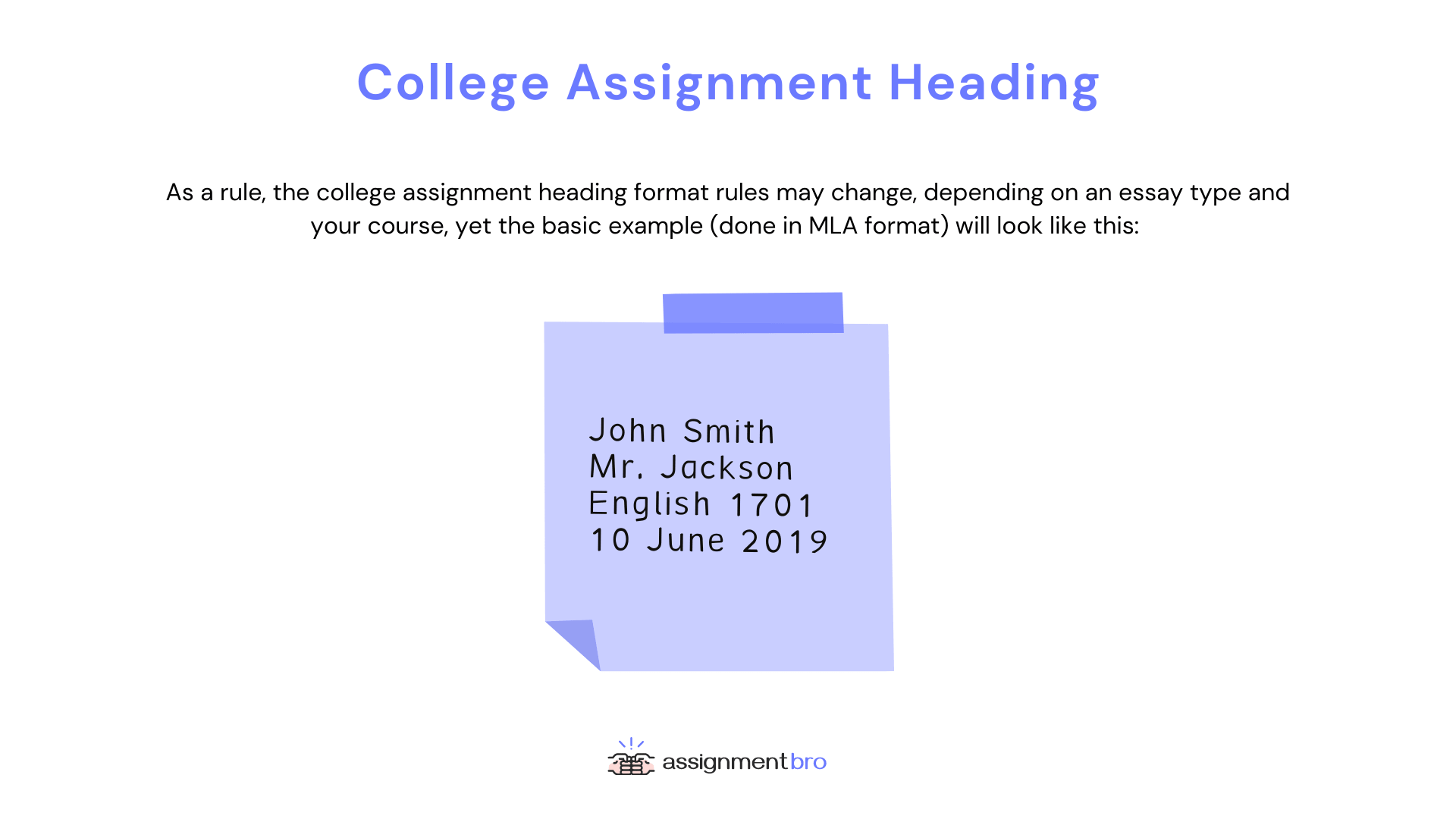How to Make College Assignment Heading
Table of Contents

The General Assignment Header Guidelines
If you have written at least one assignment, you must have faced a college homework heading. You might remember how it is done in MLA style (at the very beginning of your paper) where the student’s name must be included on the first page, followed by the professor’s name, course name, and the delivery date. It is the most widespread assignment heading that students get to learn. It has a clear purpose: to help college professors identify the paper and enter relevant information in the grading book. Also you can get affordable assignment help at our writing service.
As a rule, the college assignment heading format rules may change, depending on an essay type and your course, yet the basic example (done in MLA format) will look like this:
John Smith
Mr. Jackson
English 1701
10 June 2019
According to the MLA Style manual, it is obligatory to place this information in the top left corner of the front page with the header’s inclusion of the student’s last name and the page number in the top right corner. Depending on your academic writing format, it may be necessary to compose your assignment’s header in Chicago or APA format, which will require specific templates.
What makes all formats unified, however, as you learn how to title things, is the student’s name, the title of the paper, course name, institution, professor, or academic advisor being mentioned, and the date of the research project or an essay.
How to Head an Assignment?
Regardless of what formatting style you have to follow or when you ask for online essay writing, make sure that you locate and write down the following information:
- Identify the paper style that you have to implement for your assignment. It is necessary to include all the necessary details that will be unique if it is a lab report or a research paper.
- Headings and margins. It is vital to make sure that your paper meets the same page margins from all sides. In most cases, it will be a 1-inch margin.
- First and Last Name must be included exactly in the same way as it is mentioned in your student’s card. The same relates to online courses to help keep your grading book active.
- Professor’s name part has to come next in most academic formats. Remember that in certain cases, it is necessary to consult with your college professor since it may be either “Professor Jones”, “Dr. Jones”, or simply “Jones” unless specified otherwise.
- The Course Name. This college assignment heading part may include a special code for your course like “ENG 201” or “Social Sciences Unit”. Always consult your academic advisor to get things right. Specifying the wrong course may not be considered a serious offense, yet your final grade may be deducted.
- Date. It always depends on the country and the calendar style that is being used. It is one of the most common mistakes that modern students make as they do not check this part in advance or pick examples from the Internet. The military date style is preferred in most cases.
Remember that the title of your paper should always be centered and double-spaced, according to most formats. The only exception is the inclusion of running headers in APA format, which will always be aligned to the left and will include CAPS and a shortened title of your paper. The latest edition of APA 7 does not require the “Running Head” prefix and only asks for the paper’s title, all in capital letters.
How to Make Assignment First Page
A quality cover sheet is also required during the creation of term papers. If you have difficulties with request “write my coursework“, you can order a whole term paper from AssignmentBro professionals, who together with the title page will be able to write for you the whole term paper on any topic.
You have two options to write an assignment first page:
- Download your university’s cover page template.
- Make your own from scratch.
- Find free templates and replace the information for your paper type with all the obligatory fields that must be included.
In either case, your assignment title page will always depend on your academic writing format (APA, MLA, etc).
Your assignment can be completed in 3 hours! Has your deadline come quicker than you expected? No worries! We have what you need – a 3-hours deadline option! All features available for any other order applied, including:
Page Formatting Heading Rules
While these often differ between styles, the majority of academic formats will also require learning about the page layout rules. Even when you download freely available assignment header templates from the web, make sure that they have:
- One-inch margins on left and right, top, and the bottom of the page.
- Times New Roman, 12 point font is used or Arial 12pt.
- Text and heading part must be double-spaced.
- Text of the paper is aligned to the left with the 1/2 inches indent for every paragraph.
- The block quotes must follow the same rule.
- Your bibliography part should use hanging indents for every second line of the reference, which also relates to the general heading guidelines for college assignments.
In case of doubt, always consult a relevant style manual! Get management assignment help if you have trouble with this.
Why College Assignment Heading is Important
Working with a cover page for a university assignment is a part of every curriculum, which is a reason why so many professors recommend passing the general English course. It will help to learn how to format your tasks accordingly. It may seem challenging at first, yet knowing how to write a professor’s name on paper will also help you to avoid plagiarism and embarrassment when you send the wrong assignment by accident. Once there is relevant information found in your assignment heading, educators from the other courses or fellow students can easily find and identify every lost college paper in case of necessity.
General Topics For Assignment
- How to stop wasting paper and save trees?
- Effective Teaching
- How do stereotypes appear in society?
- Human impacts on forests
- Should more films about environmental issues be produced?
- Eyewitness testimony & memory: the correlation between them
- Internationalizing Student Learning
- Innovative Practices
- Leading Internationalization
- Can overpopulation be managed?
- Steps necessary to end cyber crimes
- Is artificial intelligence going to dominate the planet?
- Credit for Prior Learning
- How to reduce global warming?
- Attention-deficit syndrome: myth to justify persons or reality?
- Global Partnerships


 Log In
Log In
